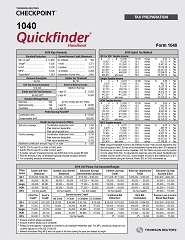We're available Monday to Friday from 8 a.m. to 6 p.m. eastern time.
Need help right now? Call 1-800-431-9025.

The 2025 1040 Quickfinder Handbook will be available in December 2025. Pre-order your Handbook today.

The 1040 Quickfinder Handbook is your trusted source for quick reference to tax principles that apply when preparing individual income tax returns. It covers all aspects of preparing a Form 1040, including tax law changes and IRS developments, and is presented in a concise, easy-to-use format.
With the 1040 Quickfinder Handbook, you’ll be on top of the ever-changing tax rules that apply to your individual client returns. Whether determining how the tax rules apply to a particular transaction or event, or how to report a particular tax item on the return, or simply looking up an amount or rate, the Handbook gets you the accurate answers you need quickly. Here’s what you’ll get with this useful tool:
See information above for new edition availability. To order the current or prior tax year editions, please call us at 800-431-9025.